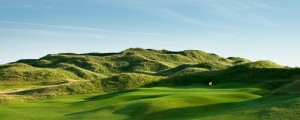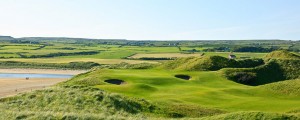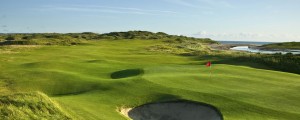Lahinch Course Review
For me, one of the most enjoyable things about playing the links golf courses on the west coast of Ireland is that they all have a different character. They may share a location, but they don’t share a personality (if that’s the word to use). I like the fact, too, that this leaves you to debate the merits of each back in the clubhouse and that there’s no obvious “best”, it’s all about personal preference.
You have Tralee Golf Club, for example, where you’ll encounter unfathomably spectacular views, while at Doonbeg, the modern course design is what impresses you most, with its sensitive use of the ancient linksland.
 Nearby you’ll also find Lahinch Golf Club in Co. Clare, less than an hour from Shannon airport. Here the golf course exudes an unmistakable charm that creates a character very much its own. And it’s not just the golf course, with its enchanting holes like the ‘blind’ par three fifth, but also from its quirks and idiosyncrasies. Take the Lahinch Goats. Legend dictates that if the Lahinch Goats are in sight there’s turbulent weather approaching, but if they’ve wandered to the far reaches of the links, and therefore out of view of the clubhouse, you’re set fair. So, nice as it is to see them roaming the land, you prefer not to.
Nearby you’ll also find Lahinch Golf Club in Co. Clare, less than an hour from Shannon airport. Here the golf course exudes an unmistakable charm that creates a character very much its own. And it’s not just the golf course, with its enchanting holes like the ‘blind’ par three fifth, but also from its quirks and idiosyncrasies. Take the Lahinch Goats. Legend dictates that if the Lahinch Goats are in sight there’s turbulent weather approaching, but if they’ve wandered to the far reaches of the links, and therefore out of view of the clubhouse, you’re set fair. So, nice as it is to see them roaming the land, you prefer not to.
Playing the Course
Lahinch has one of the most distinguished reputations in golf. Founded in 1892, the Old Course is consistently ranked amongst the best courses in the world, having been originally designed by Old Tom Morris and modified by Alister MacKenzie (of Augusta fame) in the 1920s. But Lahinch hasn’t rested on its laurels, and has continued to adapt and improve with renovations as recently as 2003. Overseen by Martin Hawtree, these sensitive design alterations have allowed Lahinch to keep pace with the progression of the modern game, as the club looked to restore the ‘Mackenzie’ course without compromising its reputation. This has been beautifully achieved.
Front Nine
Set in the shadow of the clubhouse and pro shop, the uphill first requires a fearless start. On a busy morning I can imagine the cauldron atmosphere building here. The tee shot is by no means the hardest but it certainly favours those with a right to left ball flight. Once you’re away, be aware that everything ahead of you tends to feed your ball to the right, including your approach to the green. With a gradual but significant rise in elevation, too, the first presents a tougher start than first impressions might suggest.
 Fortunately, the par five second heads back down towards the village of Lahinch and offers an immediate chance to get the score going. The second shot can feel like you’re playing from a launch pad, but the key is threading your approach through the bunkers before the green. Achieve that and you’re set up nicely for a good score.
Fortunately, the par five second heads back down towards the village of Lahinch and offers an immediate chance to get the score going. The second shot can feel like you’re playing from a launch pad, but the key is threading your approach through the bunkers before the green. Achieve that and you’re set up nicely for a good score.
Teeing off on the third has you heading boldly into the dunes and simply reaching the raised fairway will, for many, be an early test of the very limits of their long game. It’s a dramatic tee shot and extremely punishing for anything not reaching the brow of the hill. The problems don’t end there either, as a careless approach to the green can run off steeply over the back. And now you have to contend with views of the rugged coast that are liable to distract you entirely. Still, the distraction may be very welcome by then.
The fourth and fifth, ‘Klondyke’ and ‘Dell’, as they are affectionately known, are the iconic holes of Lahinch. Klondyke isn’t a long par five but presents a second shot that is as fun as golf gets. Presuming you’ve threaded a tee shot into the fairway, the challenge is to negotiate 35 feet of sand dune towering in front of you. Apart from a white stone at the top of the mound telling you where to aim, it’s a totally blind shot that requires the perfect strike, a little luck and ideally a wealth of local knowledge. The green ahead lies just in front of a boundary stone wall, which could very easily come into play.
Heading back towards the Atlantic, Dell measures approximately 150 yards on the card, but you’ll probably want to be a little more exact in accounting for the wind, as the hole is again hiding behind a 30 foot dune and you’ll be keen to have some idea of where you’ve hit it. Short but majestic, there is so little margin for error with long grass and steep banks collecting anything that misses the green. I know some feel blind shots aren’t a fair part of the game, but I loved these holes. Two for the links purist.
Once you’ve stopped smiling, the sixth is a particularly fine dogleg left par four. Avoiding the ravine liberally filled with a bunker at the brow of the fairway leaves a second shot that requires absolute precision. With bunkers lying in wait and a formidable breeze influencing proceedings, it’s a strong hole where par feels like you’ve picked up a shot.
 The tee shot on seven, played from a raised area adjacent to the beach, affords an opportunity to take in the wonderful views and forget about your score for a moment (good or bad). The hole itself runs parallel to the beach below and sets up an approach that has the potential to leave an awkward chip, as the raised green will reject anything short.
The tee shot on seven, played from a raised area adjacent to the beach, affords an opportunity to take in the wonderful views and forget about your score for a moment (good or bad). The hole itself runs parallel to the beach below and sets up an approach that has the potential to leave an awkward chip, as the raised green will reject anything short.
The eighth is a beautiful par three played slightly uphill to an undulating green. Thankfully the surrounding dunes add more to the aesthetic than to your score card, as they just supply a backdrop and (depending on the time of day and the weather) a host of shadows cast across the putting surface. Coupled with the rolling Atlantic linksland in view, the dunes make this one of the most picturesque holes on the course.
Playing downhill, the ninth is a much tougher examination than appearances would suggest. You must keep your drive on the left side here, as the approach from the right makes the long green exceedingly tough to hold. Be prudent and you might score well but, like every hole at Lahinch, par doesn’t come easy.
Back Nine
The opening hole of the back nine offers little rest. The fairway of this par four is relatively benign but it’s imperative you find it as the rough ground on either side will prevent any opportunity of advancing much distance with your second. The green is well protected too, both by bunkers and its elevation, so a par even from the fairway is no mean feat.
The eleventh may not measure as the longest par three, but the prevailing wind necessitates more club than the yardage would imply. It’s a delightful hole that seems to thread through the dunes, and acts as the curtain raiser to the fantastic par five twelfth.
 Hugging the line of the Inagh River, this hole doglegs gently to the left whilst O.O.B remains a constant threat. The simple option is to steer down the right half of the hole, but of course the par five plays longer if you do. For the courageous, it’s a definite birdie opportunity, but if ever there was a time not to “bite off more than you can chew’” this is it.
Hugging the line of the Inagh River, this hole doglegs gently to the left whilst O.O.B remains a constant threat. The simple option is to steer down the right half of the hole, but of course the par five plays longer if you do. For the courageous, it’s a definite birdie opportunity, but if ever there was a time not to “bite off more than you can chew’” this is it.
The thirteenth provides a persuasive case for the notion that ‘every great golf course should include one driveable par four’. As is right, the risks associated with the aggressive play are severe, with cavernous craters filled with thick rough on the right and bunkers waiting to gobble up the errant shot left. Opting for the conservative play might be the preference of experienced members, but for the naive visitor it’s a great temptation to go for the green!
Whilst fairly flat, the charms of the long par four fourteenth come from the two dunes that sit short of the green. These dunes provide nothing more than a glimpse of the green, meaning the approach needs to be threaded through the eye of a needle or sent towering over the top. Any errors and you’ll be left with an impossibly difficult up and down.
The fifteenth presents the last lengthy challenge on the course. Quite simply, you’ll need two great shots just to be in with a chance of par. And so the turn for home is very welcome as the par three sixteenth heads down the hill. Hitting the well guarded green is essential, with a plethora of bunkers and hollows nearby.
The tee shot on seventeen is classic links, with creeping rough guarding the wayward strike, and folds in the fairway dictating where the second is played from. Avoiding the quirky bunkers may present a birdie opportunity but even if not, this is an attractive hole to savour.
The final hole is one of the more forgiving at Lahinch. A mid-length par five where undulations in the fairways seem to dissipate gently as the hole progresses. The large flat green is nestled just to the left hand side of the clubhouse, but a birdie chance will only become available if you can avoid the scattering of fairway bunkers as you draw towards the conclusion of the round.
Recommendation
Having played Lahinch, Tralee and Doonbeg within a matter of a few days, I was left choosing a favourite. I have now had six months to ponder this question, and in truth, I’m still no closer to an answer.
Lahinch has an ‘old school’ charm with magical golf holes that are impossible to replicate. Doonbeg provides an internationally renowned modern classic, sympathetically woven into the environment, and Tralee is all breathtaking views and world class golf holes. And then there’s Ballybunion. Oh yes, the famous Ballybunion. I guess that will have to wait for my next trip as the only way I’ll work out my own personal favourite will be to play them again (and, no doubt, again). If there is a finer corner of the golfing world than this I’m not sure I know it.